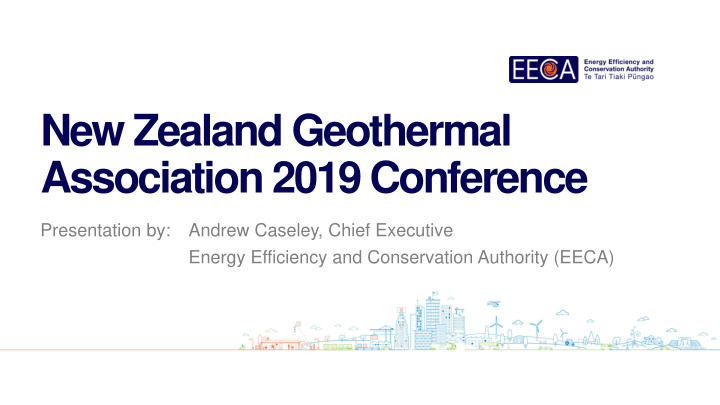



New Zealand Geothermal Association 2019 Conference Presentation by: Andrew Caseley, Chief Executive Energy Efficiency and Conservation Authority (EECA)
Current state New Zealand’s greenhouse gas emissions Over two thirds of the Energy use in New Zealand energy used in New Zealand comes from non- Non-renewable renewable energy sources Renewable 210.5 PJ Nearly 41% of New Zealand’s Households 0.8% 53.0% greenhouse gas emissions come from the energy sector Light vehicles 13.4% 155 PJ 99.9% Other transport 6.4% 84.6 PJ 76.5 PJ 63.9 PJ 53.9% Manufacturing industries Agriculture Energy 99.9% and construction 8.6% 48.1% 40.7% 29.2% Agriculture, Forestry, 0.1% 3.2% 0.1% 47.0% Fishing and Commercial 46.1% 70.8% Electricity generation 4.4% Agriculture, Households Light vehicles Other transport Industrial Forestry, Fishing Fugitive emissions 2.4% and Commercial Other energy industries 1.5% By mid-June 2019, there were over Industrial processes 14,500 6.1% Waste electric vehicles registered in New Zealand. 5.1% Five years ago there were only 250 Source: Greenhouse Gas Inventory 1990-2017, MfE (2019); Light vehicles and Other transport estimates based on data from the MBIE 2017 energy balances and MBIE Energy in New Zealand (2018)
EECA’s Strategic Focus Areas Energy Government Low Carbon Efficient and Engage Hearts Productive Low Emissions Efficient Leadership and Minds Homes Business Transport
Efficiency First • Energy Efficiency remains one of the greatest cost/benefit initiatives Source: Economic Energy Potentials Tool 2016. EECA (2017)
Efficiency First Energy efficient technology can cost less than new generation Long run marginal cost of energy efficiency and generation projects $/MWh 120 Gas baseload 100 Wind 80 Geothermal 60 Hydro Energy efficiency 40 Generation only curve 20 0 0 2,000 4,000 6,000 8,000 10,000 12,000 14,000 16,000 18,000 20,000 22,000 24,000 Cumulative GWh Sources: EECA analysis, Lazard LCOE V12.0
Efficiency First • Retrofitting existing energy systems • New Investment opportunities • Utilising the digitalisation revolution • Well planned maintenance • Price signals through the Emissions Trading Scheme • Further Regulation • Developing professional capability
“Innovations” in Energy Use • Business • Heat Pump Technologies • Electrode Boilers • Heat Capture and Reuse • Transport • EV’s • Hybrid Vehicles • Hydrogen – where will it go commercially? • Residential • Hot Water • Lighting • Space Heating
Increasing supply of renewable generation • Geothermal will meet some demand • Wind will be key • Solar • Grid scale booming worldwide • Commercial/Industrial scale will develop • Residential still has high payback scenarios • Community schemes evolving • Hydro • Environmental considerations dictating • Smaller scale to continue • Biomass • Options evolving but hampered by security of supply and cost • Liquid Fuels are still costly
Questions?
Recommend
More recommend